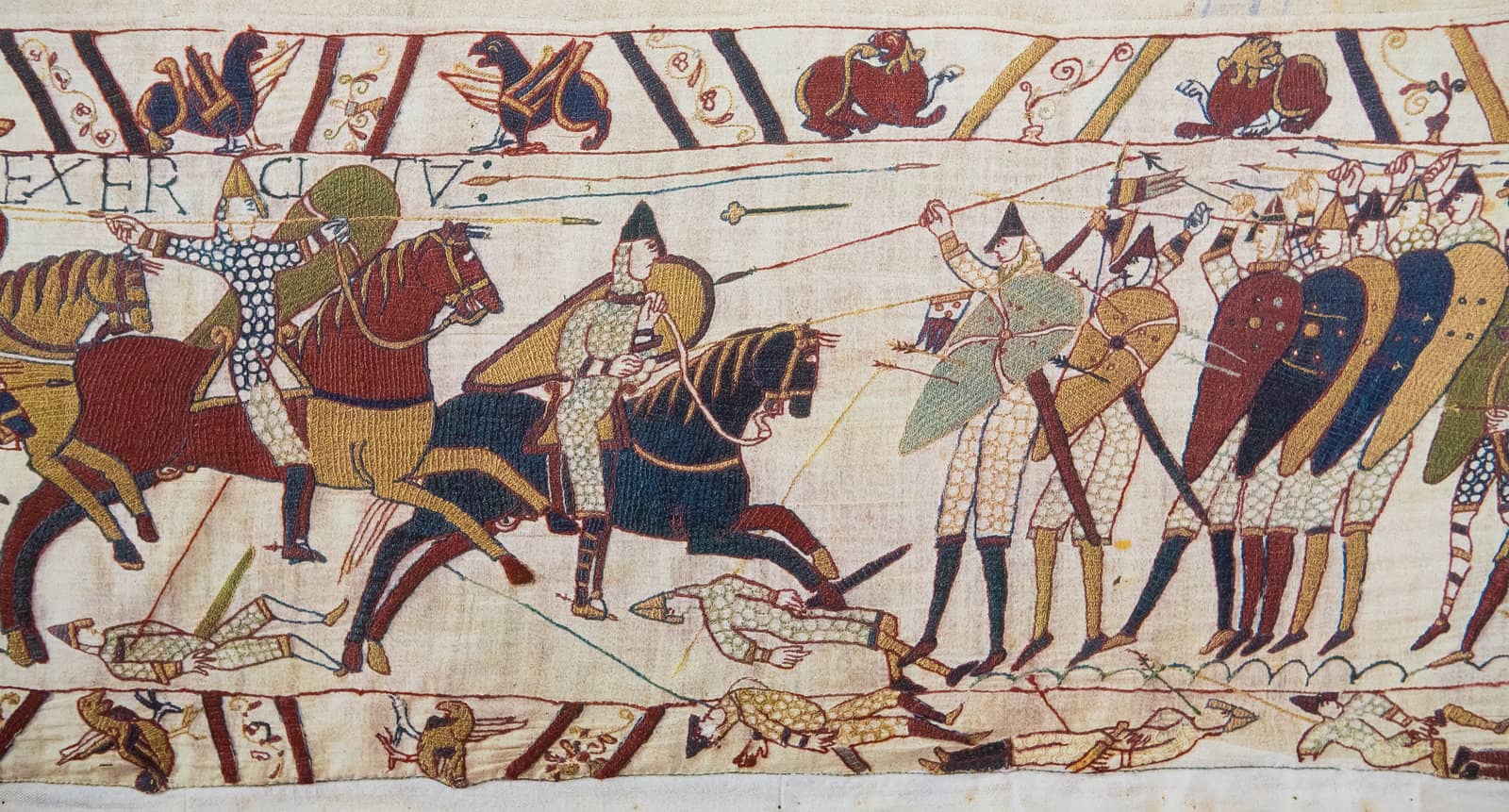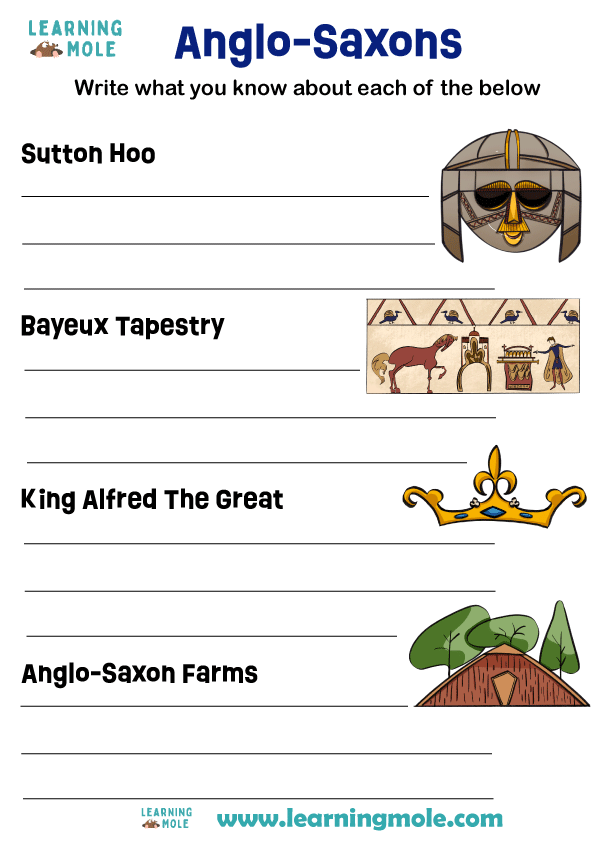
6 Amazing Facts about the Anglo-Saxons
Fact Number One: There was an Anglo-Saxon King so successful they called him Alfred The Great
King Alfred the Great is one of the most well-known English kings of all time. He was King from 879 until his death in 899. He is the only English king to ever be given the title of ‘the great’. What made him so great?
He successfully defended his kingdom, Wessex, from the Vikings when he was only 21. He developed his own currency and he helped to make towns stronger so they would not be attacked by Vikings. He was seen as a strong and fair leader, both great things for a king to be.
Table of Contents

Fact Number Two: The Anglo-Saxons created a tapestry that was almost 230 feet long
The Bayeux tapestry is a true work of art but it isn’t actually a tapestry, it’s a huge work of embroidery. The Anglo-Saxons were very good at embroidery! They created the longest tapestry in the world which depicts the Roman conquest of England and the battle of Hastings in 1066. The pictures were probably drawn by men but all that stitching was done by women. That’s a lot of stitching!
There are a lot of interesting things on the Bayeux tapestry such as Hayley’s Comet. This comet only appears in the sky every 75 years and had never been shown in pictures before the tapestry was made.

Fact Number Three: The Anglo-Saxons named England
When the Anglo-Saxons first arrived in Britain, England didn’t exist yet. The place that would become England was home to four kingdoms, the largest was Mercia.
When England was created it was named the Land of the Angles meaning the Anglo-Saxons. Then it changed to be Engla Land and then later it was shortened to England.
Fact Number Four: The Anglo-Saxons were also farmers
The Anglo Saxons are known for their fierce warriors but they were also farmers. The Anglo-Saxons lived off the land and grew their own food.
The Anglo-Saxons grew grain to make bread and porridge. They grew vegetables and kept animals for milk and meat. They didn’t like to waste anything so they used animal fat to light their lamps.
They also loved a good party and would roast meat on a fire, eat bread, and enjoy music and stories late into the night.
Fact Number Five: One of the most important archeological sites in the UK is an Anglo-Saxon gravesite
A man called Basil Brown was an amateur archeologist who made the discovery of a lifetime in 1939. He found one of the most important archeological sites ever found in the UK. The site was called Sutton Hoo and would reveal a very interesting Anglo-Saxon gravesite.
The site revealed the outline of a burial ship and a trove of Anglo-Saxon treasures that would tell us so much about how they lived. The burial chamber contained gold, silver, and a beautiful Anglo-Saxon helmet.
We don’t know who was buried there but it might have even been an Anglo-Saxon king because of the fancy jewels that were buried with the body.
Fact Number Six: The early Anglo Saxon Britain was seven different kingdoms in one.
Anglo-Saxon Britain was divided and ruled very differently from the way we know it now. By 556, Britain was divided into 7 Kingdoms: Northumbria, Mercia, Wessex, Sussex, Kent, Essex and East Anglia. Each was ruled by a different king. They fought to defend their kingdom or take control of other kingdoms.
- Northumbria: Located in the northern part of England, Northumbria was one of the earliest Anglo-Saxon kingdoms. It was known for its warrior culture and fierce resistance against Viking invasions. Northumbria included two main sub-kingdoms, Bernicia and Deira, before they were unified.
- Mercia: Mercia was situated in the Midlands of England. It was one of the most powerful and long-lasting of the Anglo-Saxon kingdoms. Mercia’s kings, like Offa, were known for their strong rule and military prowess.
- East Anglia: East Anglia encompassed the eastern part of England, including Norfolk and Suffolk. It had a strong maritime tradition and played a significant role in trade and commerce.
- Wessex: Wessex, located in the southwest of England, was the kingdom of Alfred the Great. It became a dominant force in the late Anglo-Saxon period and played a crucial role in defending England against Viking invasions.
- Essex: Essex was situated in the southeast of England, around London. It was an early Anglo-Saxon kingdom and was influenced by its proximity to the Roman city of Londinium (London).
- Kent: Kent, also in the southeast, was another of the earliest Anglo-Saxon kingdoms. It was known for being one of the first areas in England to convert to Christianity, thanks to missionaries like St. Augustine.
- Sussex: Sussex was located in the southern part of England. It was historically divided into two sub-kingdoms, Sussex and South Saxon. The kingdom had strong connections to the sea and trade.
Throughout the Anglo-Saxon period, these kingdoms were often in competition with each other, forming alliances and occasionally warring with one another. Their cultures and dialects varied, and they contributed to the development of the English language and early English history.
The Viking invasions in the 8th and 9th centuries disrupted the stability of the Heptarchy, eventually leading to the unification of England under the rule of the Kingdom of Wessex and the emergence of a single English monarchy
Why not subscribe to our LearningMole Library for as little as £1.99 per month to access over 1200 fun educational videos.
Why not try to do some research and complete the activity below:



Leave a Reply